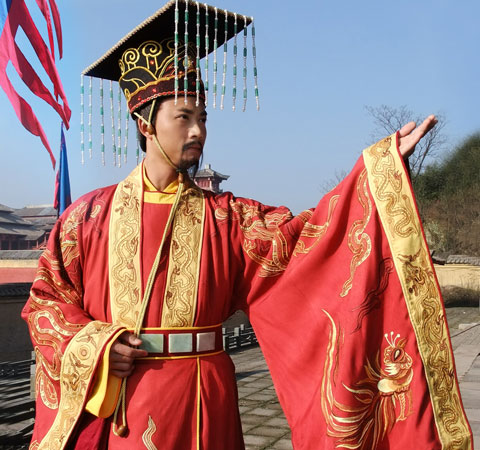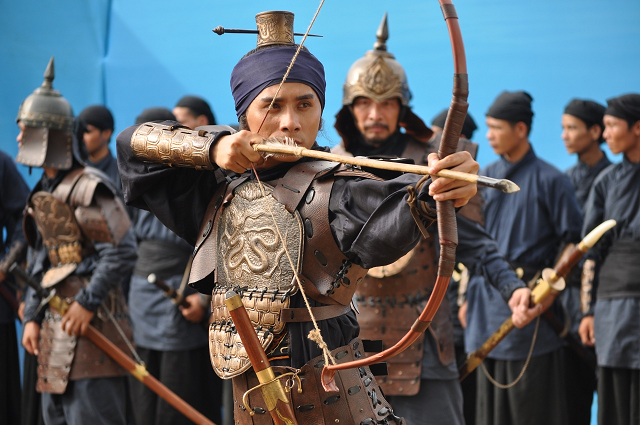There were several films and TV series made recently about Lý Công Uẩn. They were meant to coincide with the 1,000-year anniversary of Thăng Long/Hà Nội, but some were not completed in time and others were criticized.
One production that was heavily criticized was “Lý Công Uẩn—Đường tới thành Thăng Long” [Lý Công Uẩn—The Road to Thăng Long]. This 12-part TV series was a joint production of the Trường Thành Company in Hanoi and EASTV in Hong Kong. Trường Thành provided the money, and EASTV produced the series.
Shot mainly in Zhejiang Province and costing about 100 billion dong or 5.3 million dollars, the final product was criticized in Vietnam as essentially a “Chinese film in Vietamese.”
Let’s think about this. The director and one executive director were Chinese, while one executive director was Vietnamese. Together they created a TV-series that looks very “Chinese.”
Now, there is historical evidence that Lý Công Uẩn was from Mân [i.e., what is now the area of Fujian Province] and that he had Mân people working for him. And as I wrote here, the Trần were also reportedly from Mân.
Then look at the early “Vietnamese” materials we have. The Đại Việt sử ký toàn thư is modeled after Sima Qian’s Shiji [Historical Records]. The Thiền uyển tập anh emulates Daoyuan’s Jingde chuandeng lu [Record of the Transmission of the Lamp (compiled) in the Jingde Era]. The Truyền kỳ mạn lục follows the style of Qu You’s Jiandeng xinhua [New Tales Told by Lamplight]. The Lĩnh Nam chích quái explicitly states in its preface that it is written in the style of Gan Bao’s Soushen ji [In Search of the Supernatural].
So what is the problem with creating a TV series about Lý Công Uẩn that looks “Chinese” in content and style when Lý Công Uẩn himself and some of his officials probably were from an area in what is today “China” and when the educated elite at that time created history and stories about themselves which employed forms of expression that had already been created by “Chinese”?
I don’t think there is a problem with any of this. However, I still don’t like “Lý Công Uẩn—Đường tới thành Thăng Long,” not because it looks “Chinese” but because it looks too much like a “low quality modern Chinese historical drama.”
Simply put, everything about it looks fake. I feel like I’m on an artificial movie set. I don’t feel like I’m being taken back a thousand years in time.
A film which does succeed better in taking me back in time is “Khát Vọng Thăng Long” [This title has been translated as “Aspirations of Thăng Long” and “The Prince and the Pagoda Boy”].
Although the presentation of this movie in its trailer (and that is all I’ve seen) is very much influenced by Hollywood, and while the martial arts scenes will make people think of modern “Chinese” films, the colors, costumes and scenery in this movie do not look as fake as those in “Lý Công Uẩn—Đường tới thành Thăng Long.”
That said, the costumes in this movie are still not as realistic as they could be. When I heard years ago that films about Lý Công Uẩn were being made, I wondered if anyone would consult historical texts to find information about what people looked like at that time.
One extremely valuable work is a record which, Chen Fu (also known as Chen Gangzong), an envoy from the Yuan Dynasty court, compiled after visiting Đại Việt in 1293.
This work records that men at that time all shaved their heads. Indeed, it said that “the people are all monks.” The only individuals who covered their heads were officials, who wrapped a blue/green (thanh 青) turban around their heads.
In this respect, Khát Vọng Thăng Long is somewhat accurate in the turbans that it has officials wearing. But if when Chen Fu said about the late thirteenth century applied to the period around the founding of the Lý Dynasty then under that turban we should not see any hair.
On this question of hair, Lê Quý Đôn recorded in his Kiến văn tiểu lục that the Ming Dynasty official, Huang Fu, banned the cutting of hair, and that it was therefore only from the early fifteenth century that men let their hair grow long.
In 1293, Chen Fu also recorded that people went barefoot, and that the skin on their feet was very thick. He also said that men and women bathed together in the same river (that scene would have to appear in a Hollywood movie!).
Chen Fu also recorded that slaves had tattoos on their foreheads which indicated who they belonged too, such as “quan trung khách” (官中客) to indicate that they belonged to an official.
Finally, Chen Fu said that men and women both wore clothes that were black.
So while Khát Vọng Thăng Long does seem to do a better job at capturing the past than the TV series Lý Công Uẩn—Đường tới thành Thăng Long, there is more that could be done. Nonetheless, it looks like this movie does succeed in taking its viewers to someplace other than an artificial movie set.
And on the issue of these films being too “Chinese,” again, the elite in the Red River Delta at the time of Lý Công Uẩn shared a great deal with the elite in areas to their north, particularly culture and religion, but even blood. Making a movie that depicts a land that was completely unique would be just as problematic as making it “too Chinese.”
The best solution is just to aim for historical accuracy. But of course it’s also a good idea to add a sexy river bathing scene (Hollywood style) so that people will buy tickets to watch. Or even better, do it Bollywood style with lots of young men and maidens singing and dancing as they frolic in the water. . .






This Post Has 4 Comments
I would like to share with you some of my thoughts on the issue of the relationship of the Bach Viet and Dai Viet. This is not an academic study. It’s the common sense approach to certain historical issue like the one that you’d ađdressed above.
ngancanhhac (nguyen xuan phuoc)
http://www.anviettoancau.net/anviettc/index.php?option=com_content&task=view&id=1483
Nguyễn Xuân Phước
BÁCH VIỆT TRONG LÒNG ĐẠI VIỆT
Vấn đề người Tàu lập đế nghiệp ở Đại Việt
Sau khi đã xác định được địa lý văn hoá vùng Bách Việt chúng ta hãy trở về với một bí ẩn lịch sử của dân tộc ta. Đó là từ nhà tiền Lý (Lý Nam Đế) đến nhà Tây Sơn, một số các các triều vua lớn được sử sách của ta cho là có gốc từ Tàu.
Về Lý Nam Đế, sử gia Trần Trọng Kim viết: “Lý Bôn, có người gọi là Lý Bí, vốn dòng dõi người Tàu. Tổ tiên ở đời Tây Hán phải tránh loạn chạy sang Giao Châu, đến lúc bấy giờ là bảy đời, thành ra người bản xứ.”
Về dòng dõi nhà Trần, Đại Việt Sử Toàn Thư viết về gia phà của vua Trần Thái Tông như sau: “trước kia tổ tiên vua là người đất Mân, (có ngườì nói là Quế Lâm), có người tên là Kinh, đến ở hương Tức Mặc phủ Thiên Tường, sinh ra Hấp, Hấp sinh ra Lý, Lý sinh ra Thừa, đời đời làm nghề đánh cá. Vua con của Thừa, mẹ họ Lê … (ĐVSKTT tr 159)
Về Hồ Quí Ly, Đại Việt Sử Ký toàn Thư viết: “Quý Ly, tự là Lý Nguyên, tự suy tổ tiên là Hồ Hưng Dật vốn ở Chiết Giang, đời Hậu Hán, thời Ngũ Quí sang làm thái thú Diễn Châu.” (ĐVSKTT tr 293).
Về nhà Tây Sơn, Việt nam Sử Lược của Trần Trọng Kim viết: “Nguyên tổ bốn đời của Nguyễn Nhạc là họ Hồ, cùng một tổ với Hồ Quí Ly ngày trước…” (VNSL Trần trọng Kim tr. 144).
Như thế thì có ít nhất là bốn triều đại như Tiền Lý, Trần, Hồ, Tây Sơn đều là người gốc ở phương bắc và xuống phương nam lập nên đế nghiệp.
Phải chăng những vị lập nên các triều đại nầy là người Hán? Để giải đáp bài toán lịch sử nầy chúng ta phải xét lại hiện tượng phục hoạt của Việt tính hay ý thức Việt ở trong các triều đại nói trên.
Dear Nguyễn Xuân Phước,
Thank you very much for showing me this. It is a very interesting and important topic. Today is a busy day, but in a day or two I will try to write something about this.
Thank you again.
I saw that after your post on this topic, you have been critized in other blogs/sites for the thing you did not do at all. Specifically, some people criticize you for having the wrong Chinese characters, whereas you ACTUALLY NEVER WROTE ANY CHINESE CHARACTERS in the original post. The person who “translated” the post did write these Chinese characters, and others are trying to correct you for what you did not do. This is such a bad practice in scholarship and research, as it is a must that we check the original source before we want to make any critiques or evaluations of any ideas.
And all this made me think of the famous essay “The Death of the Author” by Roland Barthes, 1967. The argument is that the author does not control the text. People give it their own meaning. Therefore, attempting to determine the “author’s intent” is futile.
That is exactly what has happened here with your blog in general and this post in particular. Le Minh Khai has, to some extent, lost control of the text. But what is so interesting is that other people reading you are trying so hard to determine the “author’s intent.” But it’s totally impossible because the “author is dead.” He/she doesn’t control the text.
But I think you are not dead. You are still haunting so many people. Hahahahaha………….. :).
Yes, I read a comment where the person looked at (ok, I guess “read” in the sense that Barthes talked about) the blog, and seeing that one entry was on Malaysia and HK, the person concluded that I support the policies of the governments of Malaysia and the PRC to influence the school curriculum. . . If Roland Barthes was still alive I think he would be absolutely amazed!!! That is a much more extreme “reading” of a text than I think even Barthes could have ever imagined possible. We must now be in something like the post-post-post-post-post-modern world.